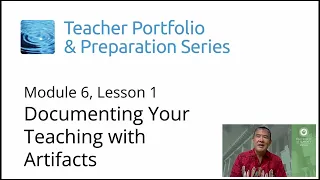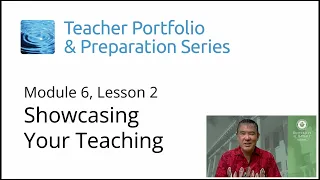
Module 6, Lesson 1: Documenting Your Teaching with Artifacts
Content: Jim Yoshioka
Presenter: Jim Yoshioka

Module 6, Lesson 2: Showcasing Your Teaching
Content: Jim Yoshioka
Presenter: Jim Yoshioka
What Is an Artifact?
An artifact is simply an example of some aspect of your teaching, often something you have created. It is evidence of your instructional practices, impact, or growth. They can be personal, practice-related, or professional in nature. Please see Module 6, Lesson 1 for more details.
ARTICLES ON ARTIFACTS
Teaching Portfolios (Vanderbilt University): This succinct article from the Center for Teaching at Vanderbilt University provides not only helpful guidelines and examples for assembling a teacher portfolio but also a comprehensive list of artifacts (called “components” in the article). Recommended reading!:
Teaching Portfolio (Center of Excellence in Teaching & Learning, University of Connecticut)
WRITING UP ACTIVITIES & MATERIALS
Imagine you are at a job interview and you just mentioned that an important part of your teaching philosophy is to give students more control over their learning. The employer asks how you actually do that in a classroom situation, and you open your briefcase and pull out an activity that illustrates exactly how you do it. That would make a positive impression on just about any employer.
If you have any original or adapted activities, lessons, modules, or projects that have worked well in class, why not write them up and include them as part of your portfolio? Take a good look at the activities to see if, or how, they reflect your philosophy of teaching.
And since you’ve made the effort to write it all out, why not take the extra step of trying to get it published? Quite a number of language teaching journals are perpetually looking for good ideas to include in their pages. Why not yours? It would be yet another item to add to your CV to make it all that much more impressive to a perspective employer.
TiPPS HANDOUT & ACTIVITY WRITE-UP EXAMPLE
Writing Up Your Activity – Steps and Samples (2023 version)
OTHER RESOURCES FOR WRITING UP ACTIVITIES & MATERIALS
Getting Published in TEFL: Why, What, Where, and How (UsingEnglish.com)
POSSIBLE VENUES FOR PUBLICATION SUBMISSIONS
Check to see if language organizations you belong to offer publication opportunities. Below is just a sample. Many have their own newsletters, resource websites, magazines, journals, and/or books and may accept anything from teaching tips and activity write-ups to articles on teaching or research to books on special topics, depending on the nature of the publication.
Keep in mind that every publication will have its own guidelines for submission and you may have to be a member in some cases. For details, check out their Publications/Resources sections:
African Language Teachers Association (ALTA)
American Association for Applied Linguistics
American Association of Teachers of Arabic (AATA)
American Association of Teachers of French (AATF)
American Association of Teachers of German (AATG)
American Association of Teachers of Italian (AATI)
American Association of Teachers of Japanese (ATJ)
American Association of Teachers of Korean (AATK)
American Association of Teachers of Slavic and East European Languages (AATSEEL)
American Association of Teachers of Spanish & Portuguese (AATSP)
American Council of Teachers of Russian (ACTR)
American Council on the Teaching of Foreign Languages (ACTFL)
Chinese Language Teachers Association (CLTA)
Computer Assisted Language Instruction Consortium (CALICO)
Japan Association for Language Teachers (JALT) – see submission guidelines for The Language Teacher
Modern Language Association (MLA)
National Council of Less Commonly Taught Languages (NCOLCTL)
Teaching English to Speakers of Other Languages (TESOL)
- Information for Authors TESOL New Ways Series – ESL activities on a variety of topics
- TESOL Connection (electronic newsletter)
- TESOL Resource Center – ESL activities, lesson plans, teaching tips, assessment tools, and more
GUIDELINES FOR TEACHER PORTFOLIO REFLECTIONS
Reflective teaching: Teaching artifacts (Central Penn College – CTE)
